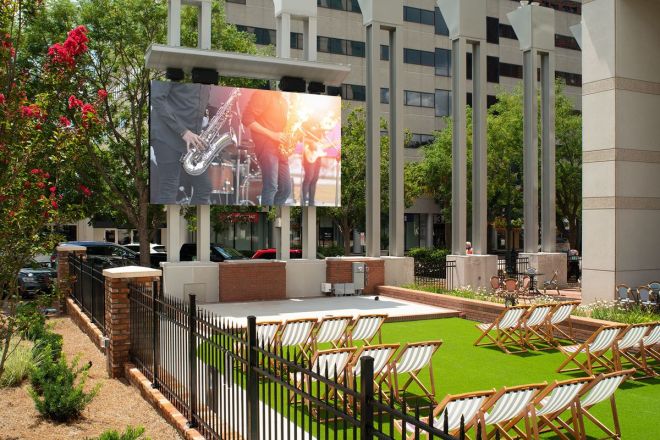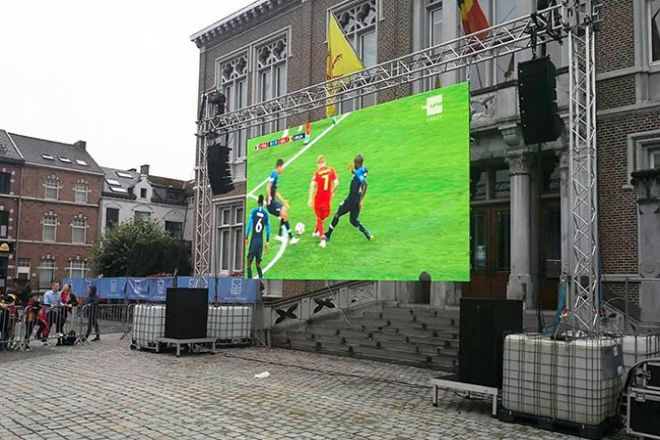Introduction

With the rapid development of science and technology and the acceleration of urbanization, LED display screens are increasingly used in public places, which not only adds beautiful scenery to the city but also provides an efficient and convenient way for information dissemination.
However, at the same time, the safety and maintenance issues of LED display screens are becoming increasingly prominent. How to ensure the safe and stable operation of LED display screens in public places and protect people’s lives and property has become an important issue before us.
1. Basic elements of LED display screen safety

1). Hardware structure design
- Selection of high-quality materials and components:
The hardware structure of the LED display screen is the cornerstone of its safe and stable operation. The selection of high-quality materials and components, such as high-quality LED chips, stable power modules, durable metal frames, etc., can ensure that the display screen is not prone to failure during long-term use, thereby ensuring its safety.
- Design a reasonable heat dissipation system:
LED display screens will generate a lot of heat when working. If the heat dissipation is poor, it is easy to cause the temperature of the equipment to rise, affecting the performance and life of the equipment and even causing safety accidents such as fire.
Therefore, it is very important to design a reasonable heat dissipation system, including the use of efficient heat dissipation fans, the setting of reasonable heat dissipation holes, and the optimization of the internal layout to ensure that the display screen can dissipate heat stably and efficiently.
- Emphasize waterproof, dustproof, anti-collision, and other protective measures:
LED display screens in public places often face various harsh environmental conditions, such as rain, dust, impact, etc. Therefore, in the hardware structure design, it is necessary to emphasize waterproof, dustproof, anti-collision, and other protective measures, such as using a waterproof shell, setting up a dustproof net, strengthening frame protection, etc., to ensure that the display screen can run stably in various environments.
2). Software system security
- Use a safe operating system and software platform:
The software system is the soul of the LED display screen, and its security is directly related to the stability of the display screen and data security. Therefore, it is necessary to use a safe operating system and software platform, such as a security-certified Linux system, professional LED control software, etc., to ensure the stability and security of the system.
- Encrypt important data and transmission channels:
For important data stored in the LED display screen, such as playback content, user information, etc., encryption processing is required to prevent data leakage and tampering. At the same time, encryption protection is also required for the data transmission channel to ensure the security of data during transmission.
- Regularly update and patch software vulnerabilities:
With the development of network technology, software vulnerabilities are constantly being discovered and exploited. Therefore, it is necessary to regularly update and patch software vulnerabilities to ensure the security and stability of the software system. At the same time, it is also necessary to establish a complete software update mechanism to ensure that users can obtain the latest software versions and patches in a timely manner.
3). Installation location and layout
- Choose a suitable installation location and height:
The installation location and height of the LED display need to be selected according to the actual situation, considering both the display effect and viewing experience, as well as safety and stability. Generally speaking, it is necessary to avoid installing it in low-lying, humid, and impact-prone places while ensuring that the installation height is moderate to facilitate people’s viewing and maintenance.
- Ensure that there are no obstacles around the display:
When installing the LED display, it is necessary to ensure that there are no obstacles around the display to avoid affecting the line of sight and heat dissipation. Especially for large display screens, it is necessary to leave enough space for people to watch and maintain, and it is also convenient for equipment such as cooling fans to work normally.
- Consider safety measures such as lightning protection and fire prevention:
When installing LED display screens in public places, safety measures such as lightning protection and fire prevention need to be considered. For example, lightning rods and other equipment need to be installed in areas prone to lightning.
Fireproof materials and fire extinguishers need to be used in places prone to fire; at the same time, it is necessary to establish a complete emergency plan and emergency rescue mechanism to ensure that safety accidents can be responded to and handled in a timely manner.
2. Daily maintenance and management of LED display screens
1). Regular inspection and maintenance
In order to ensure the normal operation of LED display screens and extend their service life, regular inspection and maintenance are essential. This includes:
- Regularly clean the dust on the surface and inside of the display screen:
The accumulation of dust will not only affect the display effect, but also may affect the heat dissipation effect, and even cause the equipment to overheat. Therefore, it is necessary to use professional cleaning tools and equipment to clean the display screen regularly.
- Check whether the power cord, data cable, and other connections are firm:
Whether the power cord and data cable are connected stably directly affects the working state of the display screen. It is necessary to regularly check whether these lines are loose, broken, and other problems, and deal with them in time.
- Check whether the cooling system is operating normally:
The normal operation of the cooling system is the key to ensuring the stable operation of the LED display screen. It is necessary to check regularly whether the cooling fan, heat sink, and other components operate normally. If there is any abnormality, it is necessary to repair or replace them in time.
2). Maintenance and maintenance records
In order to effectively manage the maintenance and maintenance of LED display screens, it is necessary to establish detailed maintenance files. This includes:
- Record the time and content of each maintenance:
After each maintenance, it is necessary to record the time, content, maintenance personnel, and other information of the maintenance in detail for subsequent reference and analysis.
- Track the operating status of the display:
Through regular inspection and maintenance, you can understand the operating status of the display, such as brightness, color, display effect, etc. For problems that arise, it is necessary to record them in time and take measures to solve them to avoid further expansion of the problem.
Establishing these records can help us better understand the operating status of the display, discover potential problems in time, and take effective measures to solve them.
3). Emergency fault handling
During the operation of the LED display, various emergency faults may occur, such as black screen, flower screen, flashing screen, etc. In order to ensure the normal operation of the display, it is necessary to establish an emergency fault-handling process and equip a professional maintenance team and spare parts.
- Establish an emergency fault handling process:
When the display fails, it is necessary to follow the emergency fault handling process, such as turning off the power, contacting maintenance personnel, etc. This ensures that you can respond quickly when a fault occurs and take measures to solve the problem.
- Equipped with a professional maintenance team and spare parts:
A professional maintenance team can quickly and accurately diagnose the problem and take effective measures to repair it. At the same time, the reserve of spare parts can ensure that the required spare parts can be provided in time when parts need to be replaced, thereby shortening the fault repair time.
3. Strategies to improve the safety and maintenance level of LED display screens

1). Formulate strict specifications and standards.
- Formulate safety and maintenance specifications for LED display screens:
In order to ensure the safe and stable operation of LED display screens, a complete set of safety and maintenance specifications needs to be formulated. These specifications should include various aspects such as equipment design, installation, commissioning, operation, and maintenance, as well as clarify various safety requirements and operating specifications.
- Strengthen the formulation and implementation of industry standards:
The formulation and implementation of industry standards are crucial to improving the safety and maintenance level of the entire industry.
We should actively participate in the formulation of industry standards, promote the continuous updating and improvement of industry standards, and at the same time strengthen the publicity and implementation of industry standards to ensure that all practitioners can understand and comply with industry standards.
2). Strengthen technical training and talent training.
- Regularly organize technical training and exchange activities:
Technical training and exchange activities are important ways to improve the professional skills of practitioners. Technical training and exchange activities for LED display screens should be organized regularly, and industry experts and technicians should be invited to give lectures and share experiences to help practitioners master the latest technical knowledge and operating skills.
- Cultivate a professional LED display screen maintenance team:
A professional maintenance team is an important guarantee to ensure the safe and stable operation of LED display screens. We should focus on cultivating a maintenance team with professional skills and rich experience, provide them with the necessary training and support, and ensure that they can handle various faults and problems quickly and accurately.
3). Introduce an intelligent monitoring and management system.
- Use technical means such as the Internet of Things and big data:
With the continuous development of technologies such as the Internet of Things and big data, they can be applied to the monitoring and management of LED display screens.
By installing sensors and monitoring equipment, the operating status, temperature, humidity, and other parameters of the display screen can be monitored in real-time, and the data can be processed and analyzed using big data analysis technology to warn of potential safety hazards in advance.
- Realize fault warning and remote maintenance:
The intelligent monitoring and management system can realize fault warning and remote maintenance functions. When the display screen fails, the system can automatically send warning information to relevant personnel, and perform fault diagnosis and repair through remote maintenance functions to reduce the impact of the fault on the operation of the display screen.
4). Establish a sound safety responsibility system.
- Clearly define the responsibilities and powers of safety-responsible persons at all levels:
In order to ensure that various safety measures are effectively implemented, it is necessary to clarify the responsibilities and powers of safety-responsible persons at all levels. Safety-responsible persons at all levels should have a clear understanding of their scope of responsibility and assume corresponding safety responsibilities.
- Strengthen safety inspections and supervision:
Regular safety inspections and supervision are important means to ensure that various safety measures are effectively implemented. Safety inspections and supervision should be strengthened, and problems found should be rectified and handled in a timely manner to ensure the safe and stable operation of LED display screens.
Conclusion
Through the discussion in this article, we can see that ensuring the safety and maintenance of LED display screens in public places is a systematic and complex task that requires multiple aspects and comprehensive measures.
Only by doing a good job in hardware design, software system, installation layout, daily maintenance, etc., can the safe and stable operation of LED display screens be ensured, and better services and experience can be provided to people.
Looking to the future, with the continuous development of science and technology, the safety and maintenance technology of LED display screens will also be continuously updated and improved.
We expect relevant departments and enterprises to continuously strengthen technology research and development and innovation, promote the continuous improvement of the safety and maintenance level of LED display screens, and bring more convenience and beauty to the development of cities and people’s lives.
Finally, if you want to know more about LED display screens, please get in touch with us.
